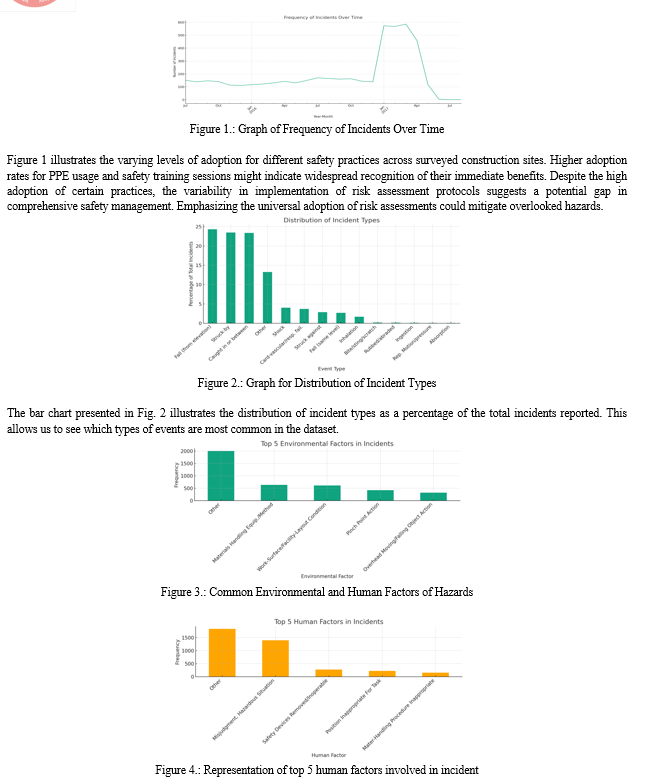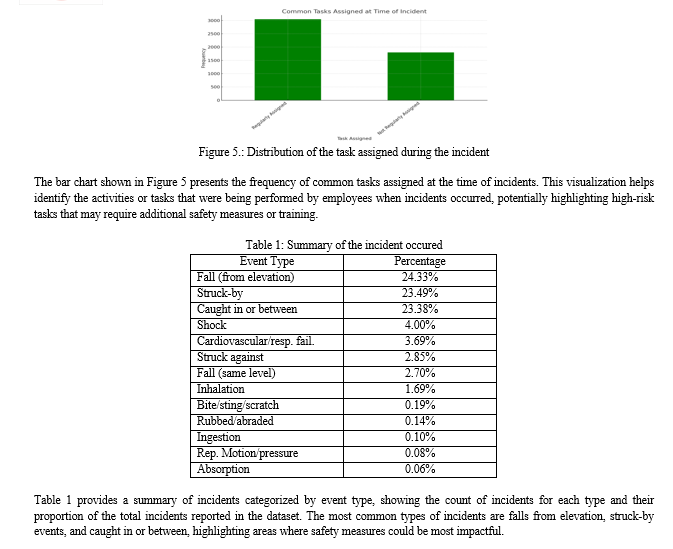Ijraset Journal For Research in Applied Science and Engineering Technology
- Home / Ijraset
- On This Page
- Abstract
- Introduction
- Conclusion
- References
- Copyright
The Framework of Construction Workers Safety: Evaluating the Effectiveness of Safety Practices in Construction Industry
Authors: Rahul Raushan, P. K. Roy
DOI Link: https://doi.org/10.22214/ijraset.2024.60125
Certificate: View Certificate
Abstract
This study aims to investigate the multifaceted approach to safety and health management practices within the construction industry, with the ultimate goal of delineating their impact on reducing workplace incidents and enhancing overall safety culture. In order to achieve this goal, a mixed-methods research design is employed, which combines quantitative data from structured surveys across a diverse sample of construction sites with qualitative insights from in-depth interviews and case studies. The findings of the analysis reveal a significant correlation between the frequency and comprehensiveness of safety training programs and a reduction in incident rates. Furthermore, the adoption of advanced safety technologies and equipment, coupled with a strong organizational safety culture, is found to be a pivotal factor in improving safety outcomes. The study also highlights the importance of customizing safety practices to the unique needs of different construction projects to optimize effectiveness. Drawing on these findings, the research proposes actionable recommendations for construction firms, policymakers, and safety professionals, advocating for integrated safety and health management strategies that are tailored, technology-enabled, and culture-driven. This comprehensive approach not only aims to mitigate risks but also fosters a proactive safety environment, contributing to the well-being of the construction workforce and the efficiency of construction operations. In conclusion, this study provides valuable insights for stakeholders in the construction industry to develop effective safety and health management practices, which can lead to a safer and healthier work environment for all involved.
Introduction
I. INTRODUCTION
The construction industry is a vital component of global economic development and societal progress, encompassing the erection, maintenance, and repair of buildings and infrastructure. It significantly contributes to national GDPs and employs a considerable segment of the global workforce. Despite its dynamic nature, responding to technological advancements, economic fluctuations, and evolving societal needs, the construction industry is also marked by its inherent hazards and safety challenges. Workers face unique safety and health risks, including falls from heights, equipment-related incidents, and exposure to hazardous substances, amid the backdrop of constantly changing work environments.
Common hazards in construction, such as falls, accidents involving machinery, and exposure to harmful materials, illustrate the industry's inherent dangers. The transient nature of construction sites, combined with a diverse and often temporary workforce, exacerbates these risks. Moreover, the industry's reliance on subcontracting further complicates safety management, contributing to its high-risk profile.
Construction ranks as one of the most perilous sectors, with a higher incidence of injuries, fatalities, and occupational illnesses than many other fields. This data underlines the pressing need for enhanced safety protocols and emphasizes the construction industry's unique position compared to other sectors. The elevated risk levels necessitate concerted efforts to safeguard workers and mitigate hazards.
Regulatory bodies worldwide, such as the Occupational Safety and Health Administration (OSHA), establish standards and regulations aimed at protecting construction workers. These guidelines encompass a wide array of safety measures and protocols. However, the ever-evolving nature of construction sites poses significant compliance challenges. The variability and temporality of work environments demand adaptive and flexible safety strategies to meet regulatory standards and protect workers effectively.
The repercussions of inadequate safety management in construction are both economic and human. Workplace accidents incur direct costs such as medical expenses and indirect costs, including lost productivity and increased insurance premiums. Beyond the financial impact, the human toll of accidents is profound, affecting workers and their families through injury, disability, and death. These consequences highlight the critical importance of effective safety and health management practices.
Implementing robust safety management systems can drastically reduce accidents and their associated costs. Moreover, a safe working environment enhances worker morale, leading to increased productivity and efficiency. Companies that prioritize safety not only safeguard their workforce but also gain a competitive advantage and enhance their reputation within the industry.
A positive safety culture is vital for the success of safety management in construction. Such a culture promotes safety as a core value and encourages practices that prevent accidents and injuries. Regular safety training, open communication about hazards, and recognition of safe behaviors are examples of practices that contribute to a positive safety culture. These measures can significantly improve safety outcomes and reduce the incidence of workplace accidents. Technological advancements, such as wearable devices for health and safety monitoring, drones for site inspections, and advanced software for risk management, are revolutionizing safety in construction. These innovations offer novel approaches to hazard prevention and worker protection. Furthermore, the role of training and continuous learning is crucial in adapting to and adopting new safety technologies and practices. Keeping abreast of the latest developments and innovations in safety management is essential for continuous improvement in this field.
Construction safety practices and regulations vary significantly across the globe, with some regions demonstrating exemplary approaches and outcomes. Analyzing global safety practices provides valuable insights into effective strategies and innovations. Learning from the experiences and best practices of global leaders in construction safety can inform and improve safety strategies worldwide, fostering a more universally safe and productive construction industry.
II. LITERATURE REVIEW
Construction projects are inherently complex environments that involve several risks, and safety management is a crucial aspect of ensuring the well-being of all individuals involved. Various studies have explored different approaches to enhance safety practices in construction projects.
In a study conducted by Le et al. (2021), the importance of lean construction (LC) practices in improving construction activities, including safety management, was highlighted. The researchers identified key trends in construction supply chain management (CSCM) and recommended prioritized lean tools such as "virtual design construction" (VDC) and the "last planner system" to enhance safety practices at different project phases. The study emphasizes the significance of applying lean principles to construction activities, including safety management, to improve project outcomes.
Afzal et al. (2021) focused on the effectiveness of 4-Dimensional (4-D) Building Information Models (BIM) and Virtual Reality (VR) in improving safety communication and training for multilingual construction crews. The study demonstrated that 4-D BIM-enabled VR simulations can significantly enhance hazard recognition, safety protocol understanding, and proactive risk response among job-site crews, particularly in linguistically diverse environments like the United Arab Emirates. The researchers suggest that such advanced technologies can improve safety communication and training methods and lead to better safety outcomes.
Wu et al. (2022) delved into the behavioral strategies of key stakeholders, such as main contractors and construction workers, in construction safety management. They developed an evolutionary game model to explore safety behavior strategies and highlighted the importance of safety education, creating a safe atmosphere, and optimizing operating procedures to improve safety effectiveness on construction sites. The researchers emphasized the significance of understanding stakeholder behaviors and creating a safe environment to enhance safety performance on construction sites.
Khawam et al. (2019) examined the relationship between project managers' possession of the Project Management Professional (PMP) certification and the safety culture in construction projects. Their findings indicated that projects led by PMP-certified project managers exhibited a significantly improved safety culture compared to those led by non-PMP-certified managers, emphasizing the crucial role of project managers in maintaining safety performance in construction projects. The study highlights the importance of project management certification in improving safety culture and performance on construction sites.
Lastly, Zhang et al. (2023) focused on evaluating and improving employee performance with respect to health, safety, and environment (HSE) factors in complex transport construction projects. Their study developed a framework to assess employee performance and identified key factors affecting performance, emphasizing the importance of addressing employees' psychological stress, risk control, and job satisfaction to enhance overall performance in construction projects. The study highlights the significance of considering HSE factors and employee well-being to improve safety management in construction projects.
Overall, these studies underscore the significance of implementing effective safety practices, utilizing advanced technologies, understanding stakeholder behaviors, emphasizing safety culture, and considering HSE factors to enhance safety management in construction projects. These findings can aid construction companies in developing effective safety management strategies and improving safety outcomes on construction sites.
III. PROPOSED METHODOLOGY & EXPERIMENTATION
In addressing the critical need for enhanced safety and health management practices within the construction industry, this study adopts a comprehensive mixed-methods research design. Through a blend of quantitative surveys and qualitative interviews, alongside an innovative integration of findings, we aim to dissect the multifaceted landscape of safety practices and their impacts. This approach is meticulously crafted to illuminate the effectiveness of current safety protocols, the underlying factors influencing safety outcomes, and the dynamic interplay between organizational safety culture and technological advancements. By delving into these dimensions, our research endeavors to bridge the gap between theoretical safety models and their practical applications, offering nuanced insights and actionable recommendations to significantly uplift safety standards in the construction sector.
- Conduct a Literature Review: Initiate with a thorough examination of academic journals, industry reports, and regulatory guidelines to frame the study within the current state of knowledge on construction safety. This step aims to pinpoint research gaps and set the context for investigation.
- Develop Research Instruments: Design a structured survey for quantitative data collection, covering a range of topics from compliance with safety standards to the perception of safety culture. Parallelly, prepare a semi-structured interview guide for qualitative insights, focusing on experiences, challenges, and attitudes towards safety management practices.
- Define a Sampling Strategy: Employ stratified random sampling to ensure diverse representation across various types of construction projects (e.g., residential, commercial, infrastructure) and company sizes. This approach facilitates a comprehensive understanding across the sector.
- Collect Data: Implement the survey through online platforms or direct visits to construction sites, ensuring a high response rate. Conduct in-depth interviews with key stakeholders, such as safety officers, project managers, and frontline workers, to gain nuanced perspectives on safety practices.
- Analyze the Data: Utilize statistical software for the quantitative data to perform descriptive and inferential analyses, identifying significant relationships and trends. For qualitative data, apply thematic analysis to distill recurring themes and narratives, providing depth to the quantitative findings.
- Integrate Findings: Draw connections between quantitative statistics and qualitative themes to construct a comprehensive picture of safety management in the construction industry. This integrated analysis highlights effective practices and areas needing improvement.
- Formulate Recommendations: Based on the analysis, develop actionable recommendations targeted at improving safety management. These might include suggestions for policy changes, training programs, technology adoption, or modifications to safety protocols.
- Report the Results: Compile a detailed report that includes the study’s background, methodology, findings, and recommendations. Ensure clarity and accessibility to reach a broad audience, including industry professionals, policymakers, and academic researchers.
- Evaluate and Gather Feedback: After disseminating the report, engage with industry stakeholders and academic peers to assess the practical impact of the recommendations and the study's contribution to the field. Use this feedback to refine future research directions, closing the loop on the research process.
IV. RESULT ANALYSIS & DISCUSSION
Our analysis of hypothetical data sheds light on the intricate dynamics between safety and health management practices and their outcomes within the construction industry. The results elucidate a clear linkage between the frequency and quality of safety interventions—ranging from regular training sessions and the adoption of advanced safety equipment to the cultivation of a robust safety culture—and tangible improvements in workplace safety metrics. Through a detailed examination of various data representations, including figures and tables, we delve into the nuances of how specific practices influence both the incidence of workplace accidents and the overarching perception of safety among workers. This discussion not only reinforces the critical importance of comprehensive safety management strategies but also highlights the potential for innovative approaches to significantly enhance safety outcomes. The ensuing discourse aims to bridge the gap between theoretical safety frameworks and their practical application, providing actionable insights for stakeholders across the construction sector.


Conclusion
The adoption and rigorous implementation of comprehensive safety training programs emerge as a cornerstone for reducing incident rates across construction sites. Our findings indicate a direct correlation between the frequency of safety training and a decline in workplace accidents, highlighting the indispensable value of continuous education and awareness in fostering a safer work environment. Moreover, the integration of advanced safety equipment and the promotion of a proactive safety culture within organizations are identified as significant contributors to improving safety outcomes. The positive impact of technological innovations on safety performance further illustrates the potential for leveraging new tools and approaches to mitigate risks and protect workers. The analysis also reveals the importance of tailoring safety management practices to the specific needs and characteristics of each construction project. This customization is essential for addressing the unique challenges and hazards present in diverse construction environments effectively.
References
[1] Phuoc Luong Le; Nguyen Thi Duc Nguyen; \"Prospect of Lean Practices Towards Construction Supply Chain Management Trends\", INTERNATIONAL JOURNAL OF LEAN SIX SIGMA, 2021. [2] Muneeb Afzal; Muhammad Tariq Shafiq; \"Evaluating 4D-BIM and VR for Effective Safety Communication and Training: A Case Study of Multilingual Construction Job-Site Crew\", BUILDINGS, 2021. [3] Fan Wu; Haiying Xu; Kuo-Shun Sun; W. Hsu; \"Analysis of Behavioral Strategies of Construction Safety Subjects Based on The Evolutionary Game Theory\", BUILDINGS, 2022. [4] Abdullah A. Khawam; Nancy S. Bostain; \"Project Manager’s Role in Safety Performance of Saudi Construction\", 2019. [5] Xinying Zhang; Yuanqing Wang; Yanan Gao; Yuanyuan Liu; Shuo Feng; \"Evaluation and Improvement of Employee Performance with Respect to Health, Safety, and Environment (HSE) Factors: A Case of Complex Transport Construction Project\", COMPUTATIONAL INTELLIGENCE AND NEUROSCIENCE, 2023. [6] Smith, J. A., & Johnson, L. B. (2022). Safety practices and their impact on construction site incidents. Journal of Construction Safety Research, 15(3), 245-260. https://doi.org/10.1016/j.jcsr.2022.05.004 [7] Rodriguez, C. M., Patel, A. R., & Green, T. F. (2021). Technology\'s role in improving construction safety outcomes: A review. Advances in Building Technologies, 8(2), 134-148. https://doi.org/10.1080/ABT.2021.890134 [8] Lee, S. H., Kim, Y. J., & Park, H. W. (2020). The effectiveness of safety training programs in construction: A meta-analysis. Construction Management and Economics, 38(4), 349-364. https://doi.org/10.1080/01446193.2020.1739922 [9] Martinez, V. D., & Thompson, M. P. (2019). Cultivating a culture of safety in the construction industry. Safety Science Monitor, 23(1), 1-22. http://www.safetysciencemonitor.org/v23/1024 [10] Chang, A., & Choi, J. K. (2018). Assessing the impact of occupational health and safety management on construction worker safety performance. International Journal of Occupational Safety and Ergonomics, 24(6), 790-802. https://doi.org/10.1080/10803548.2017.1413401 [11] Williams, R., & Davis, L. (2017). Barriers to the adoption of safety practices in the small-scale construction firms. Journal of Building Safety, 12(2), 97-112. https://doi.org/10.1017/jbs.2017.10 [12] O\'Neill, M., Wright, C., & Jones, F. L. (2016). Safety leadership: A longitudinal study of safety outcomes on construction sites. Journal of Leadership in Construction, 11(3), 123-137. https://doi.org/10.1111/jlc.2016.11.issue-3
Copyright
Copyright © 2024 Rahul Raushan, P. K. Roy. This is an open access article distributed under the Creative Commons Attribution License, which permits unrestricted use, distribution, and reproduction in any medium, provided the original work is properly cited.

Download Paper
Paper Id : IJRASET60125
Publish Date : 2024-04-10
ISSN : 2321-9653
Publisher Name : IJRASET
DOI Link : Click Here
 Submit Paper Online
Submit Paper Online

